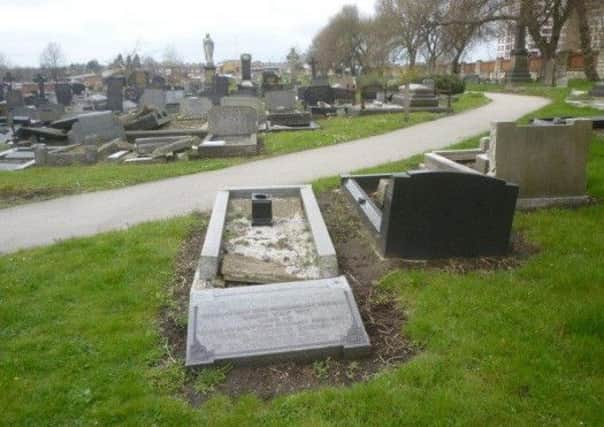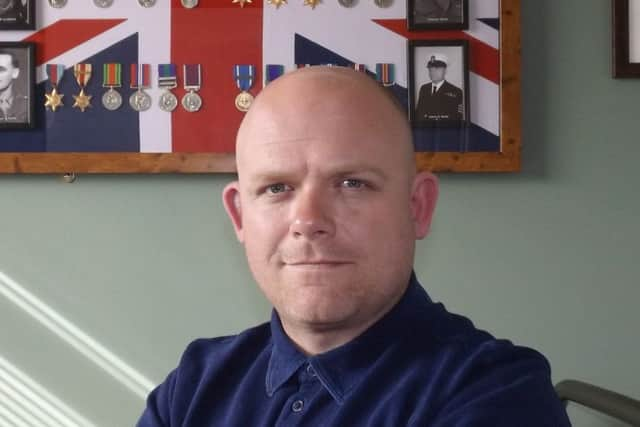Vandals wreck Doncaster war hero's grave


Solider William Webb served in the 1st (Kings) Dragoon Guards fighting in the second Boer War and the First World War.
He was recognised for his bravery by being awarded with the Military Cross.


Advertisement
Hide AdAdvertisement
Hide AdWilliam moved to Doncaster in 1922 and died in 1934 of TB. His final resting place was Hyde Park Cemetery.
Researching his ancestory, Jason Webb of Gosport in Hampshire, discovered that William was his great, great uncle, and was deeply saddened when he received pictures of the devastation caused to his headstone and plot after he requested a grave report from the Friends of Hyde Park Cemetery.
He said: “I was saddened to see that the grave has been badly damaged and was informed by the Friends of Hyde Park cemetery that this damage was caused by vandalism some years ago.
“The grave is in need of a complete restoration and it is my intention to attempt to raise funds for this to happen.


Advertisement
Hide AdAdvertisement
Hide Ad“I think it is so sad that a war hero who served in two wars, received two gallantry awards and served in the army his entire adult life has been forgotten like this and his grave left vandalised. Surely in this, the centenary of WW1, something can be done.
“I have tried to locate any family in Doncaster but have had no luck. As the grave has been in this condition for some years I think it is unlikely any family remains in the area.”
Stepping in to help Jason, Richard Bell of the Friends of Hyde Park Cemetery put him in touch with Gary Stapleton, chairman of the Doncaster-based Victoria Cross Trust, a charity dedicated to the upkeep of the graves and the memory of Victoria Cross recepients. The organisation kindly offered to carry out the repairs to William’s grave.
Gary said: “We’ve done a fair bit of work for free in the past and Richard Bell is a fan of the work we do as the methods we use doesn’t cause any more damage to the stonework.
“Richard contacted me about this grave to get it restored.
Advertisement
Hide AdAdvertisement
Hide Ad“From our perspective we are a military charity which restores VC graves, we can’t use any charity assets for Jason’s work but he has agreed to pay the costs. Our expertise we provide for free.”
He added: “William is a local war hero and he should be recognised. We’ve been out and done an assessment and it will require a reasonable amount of work to make it safe.
“We’re over the moon that we’ve been brought into this, it’s Doncaster’s heritage.”
Jason added: “I’m hoping the work can be completed in time for the centenary anniversary of the Battle of the Somme on July 1. William won his Military Cross in the closing days of the battle so it would be fitting to have it complete by then.”
William’s history
Advertisement
Hide AdAdvertisement
Hide AdWilliam Webb joined the army in 1900, serving in the 1st (Kings) Dragoon Guards (KDG). He fought in South Africa during the second Boer War in 1901/02, fighting in the Cape Colony and Orange Free State.
When the First World War started William was serving in India with the KDG which was part of the 8th (Lucknow) Cavalry Brigade.
The brigade arrived in France on November 11 1914 with the Indian Expeditionary Force. He was a Sergeant in the regiment’s Maxim Machine Gun section when he was awarded the Military Medal (MM) for gallantry at Hooge Chateau (just outside Ypres in Belgium) in June 1915 (London Gazette, October 27, 1916).
At the end of January 1916 the machine gun sections of the three regiments in the Lucknow Brigade were detached from their respective regiments and amalgamated to form the Lucknow Machine Gun Squadron. The men of the squadron were transferred to the MGC. As the Squadron Sergeant Major (SSM) William was awarded the Military Cross (MC). His citation appeared in the London Gazette on 13 February 1917 and read, “awarded for conspicuous gallantry in action. He commanded his section with great skill for fifteen days. On two occasions he carried messages across the open under very heavy fire”.
Advertisement
Hide AdAdvertisement
Hide AdThis action took place in November 1916 in the trenches just outside the village of Hebuterne. After continued gas attacks and heavy shelling with high explosive and shrapnel rounds William was left to command the two Vickers Machine Guns of 5 section when the section was left without an officer and there was no others to replace him.
Conditions were horrendous as the trenches were constantly flooded and collapsing from the relentless German artillery bombardment. The squadron spent a continuous period of 25 days in the trenches during October/November 1916 and the six machine gun sections of the squadron were in constant action providing support to the infantry and firing at laid German targets. William received his medal in June 1917 and continued to serve in France until 14 August 1917. The Lucknow Brigade returned to India in October 1917.
When William moved his family to Doncaster in 1922 he joined the Queens Own Yorkshire Dragoons and worked as the units fulltime clerk.
William died of TB at his home at Carr House Road on July 10, 1934.